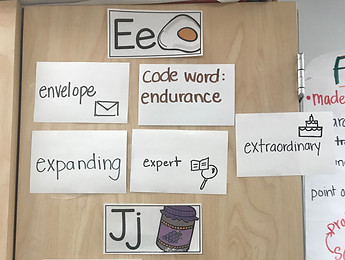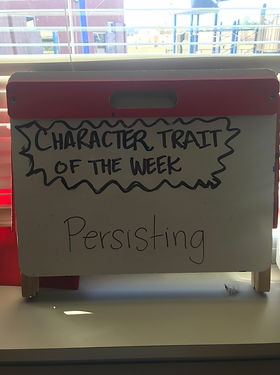Persisting
In the classroom, persisting goes by many names- perseverance, endurance, grit, sticking through something, and committing to completing a task despite challenge.
Rationale
I believe learning to follow through is a skill learned throughout a life time. Often, as humans, we are faced with serious challenges. During this adversity, true character comes out. I intend for my time as a teacher to help foster life change through teaching this disposition of success. Through teacher guidance, students have exposure to important dispositions that can develop personal growth.
First Steps
Initially I taught persisting through an explicit lesson. The lesson defined persisting and involved a great deal of whole group discussion. In this lesson, I highlighted individuals who embodied persistence- including Milton Hershey, J.K. Rowling, Michael Jordan, and Nelson Mandela. I explained persistence looks different for everyone. Sometimes our challenges are from ourselves and other times they are outside our control. Students must be vigilant to meet adversity with a mindset of sticking through until a task is complete.
In-Class Presentation supporting the Lesson
Lesson Expanded
Defining the Habit of Mind: In order to begin practicing this disposition in our daily life, students must first recognize it. To recognize, students must have awareness, and this comes through explicitly defining the mindset.
Identifying this quality in others: Through explicit quick bios, students are exposed to individuals that have faced adversity and set-backs. Discussion allowed students to process the information the lesson provided. During this discussion, English Language Learners are paired with bilingual buddies to speak in their native languages with and build English vocabulary. Visuals throughout the lesson support my English Language Learners and Special Education populations.
Action: For persisting to become a natural reaction of my students, we must create behavioral steps to practice this habit. Our closing to the lesson was to a develop a realistic and attainable action plan. These quick steps for practicing persistence will set students up to proactively respond to adversity.
Reinforcement
To ensure frequent familiarity with my students I began hiding code words around the room to keep them engaged with reading. Once finding these words they could earn a reward. The words mainly consisted of habits and academic vocabulary. I specifically utilized this strategy to reinforce persisting. When the word is found, the class has an informal conversation about the word, its definition, and examples you have witnessed or demonstrated. Through this engaging activity, students can reference habits through teacher provision in a comfortable and frequent way.

After the power point lesson, the class helped me to create an anchor chart. On it, we defined the habit of mind and developed a list of synonyms to be used throughout the year. This list broadened student vocabulary and provided greater depth to their understanding of persisting through connections to prior knowledge. On all of my anchor charts I include visuals to support ELLs.

Hidden code word on our word wall reinforcing the mindset.

Student with reward for finding hidden code word.

Grit is hidden on our interactive daily read aloud.

Hidden code word at the bottom of long standing advocacy poster.

Reinforcement
Students also find Habits of Mind reinforced weekly through our Character Traits Challenge. Since the first week of school, I have defined a new character trait or Habit of Mind. Students can nominate each other throughout the week to earn recognition on Friday. This is a quick way to name and notice students with purpose and allow students the ability to lead praise and acknowledgement of traits.

Weekly award given out during our circle announcement of Character Traits Challenge winner.
Posted easel of weekly trait.
Reflection
Through student interviewing, I encouraged students to practice their habit of meta-cognition. This metacognitive practice allowed them to demonstrate internalization of the disposition of persisting. I pulled students from all demographic populations represented in my classroom- English Language Learners, students with IEPs, Gifted and Talented, and all genders and races present. I wanted equal representation in this reflective portion.
Student describes a time they persisted to save money to pay for part of his phone. This shows a student has internalized this mindset and is applying it beyond the classroom in his personal life. This will serve him as a lifelong skill in any career by committing to a task until it is finished.
Student defines persisting as having a goal and not giving up when trying to reach it. She then describes a time she persisted to set up a yard sale to raise money for her mom. The yard sale was difficult to set up but she did not quit because she wanted to care for her mom.
Students sharing a meaningful mentor in persisting- Malcolm X. This shows the student can identify this trait in others actions. Student can start practicing those behaviors he has identified in his mindset role model .
A snapshot is a district level assessment that is given once a semester. This individual demonstrates an understanding of persistence based on her experience of setback during the snapshot. She explains her actions of persistence by continuing to work in an academic setting even when she found it difficult to focus.
This student explains he persists by going to basketball practice to get better. He has internalized that persistence requires is effort and consistent dedication. He has the ability now to identify his behaviors that this mindset and put it into daily action- out and in school.
Student identified with a learning difference discusses exact setbacks that made a task difficult to complete but how they persisted. Student growth is shown by deliberate effort to remain focused despite challenges.
Persisting in Daily Life- Student Stories

During the break from school due to COVID-19, students have been working online. A student's parent reached out to notify me that they expected their student to be hesitant with all of the work. However, to her surprise her student is persisting through the new challenge Elearning brings. She is pictured engaging with her work and electronic resources provided at home.

At the beginning of the year, daily, this student would walk in and immediately put their head down. After learning of persisting, I saw a behavioral change in her. She was far below grade-level academically but she began to try, This student began to advocate for her academic and social-emotional needs. Based on documentation this student was identified with a learning difference and with proper accommodations has been able to succeed in our class.

Student requested to leave a note on our message board about persisting during their summative assessment. The purpose of her actions were to encourage others to do their best and press on if the task was challenging.
Impact
By explicitly teaching students about persisting and reinforcing it throughout the year, students have experienced a wide range of exposure to this mindset. This exposure will set them up for a life time of endurance when facing adversity. In academics, career, or personal life, it is imperative that individuals have the social emotional awareness and ability to stick to a task until it comes to fruition. As an educator, this is one of the most meaningful pieces of wisdom I can impart on my students. No matter the field, my students will excel because they have learned to persevere and give effort in confusion, distraction, and setback.










